杀死玩家¶
我们可以通过跳到敌人身上来杀死他们,但玩家仍然不能死亡。让我们来解决这个问题。
我们希望检测到被敌人击中与压扁敌人时的不同。我们希望玩家在地板上移动时死亡,但如果他们在空中,则不会死亡。我们可以使用向量数学来区分这两种碰撞。但是,我们将使用 Area 节点,该节点适用于命中框。
使用 Area 节点制作攻击框¶
回到 Player 场景,添加一个新的 Area 节点。把它命名为 MobDetector(小怪检测器)。添加一个 CollisionShape 节点作为它的一个子节点。
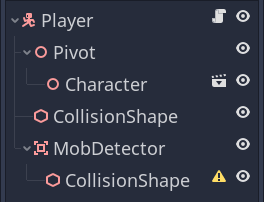
在检查器中,给它指定一个圆柱体形状。
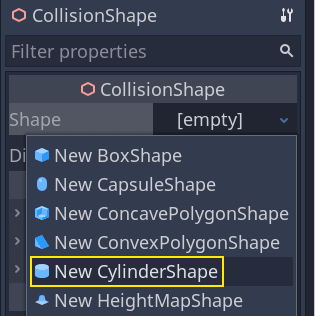
这里有一个技巧,你可以用它来使碰撞只发生在玩家在地面上或靠近地面时。您可以降低圆柱体的高度并将其向上移动到角色的顶部。这样,当玩家跳跃时,形状会太高,敌人无法与之碰撞。
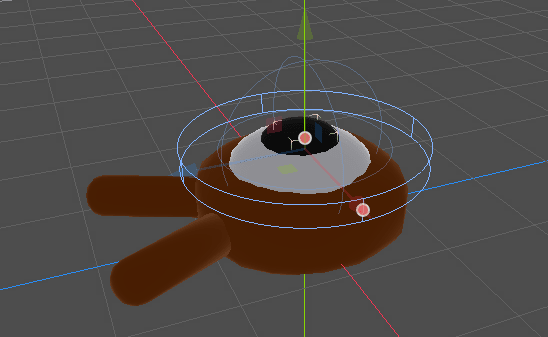
你还希望圆柱体比球体更宽。这样一来,玩家在碰撞之前就会被击中,并被推到怪物的碰撞盒之上。
圆柱体越宽,玩家就越容易被杀死。
接下来,再次选择 MobDetector 节点,并在检查器中,关闭其 Monitorable 属性。这使得其他物理节点无法检测到这个区域。补充的 Monitoring 属性允许它检测碰撞。然后,清除 Collision -> Layer,并将掩码设置为“enemies”层。
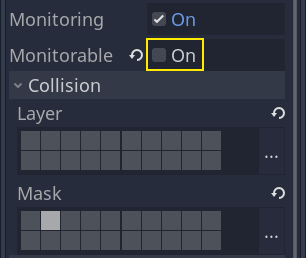
当区域检测到碰撞时,它们会发出信号。我们要将一个信号连接到 Player 节点。在节点选项卡中,双击 body_entered 信号并将其连接到 Player。

当一个 KinematicBody 或 RigidBody 节点进入它时,MobDetector 将发出 body_entered 信号。由于它只掩盖了“enemies”物理层,它将只检测 Mob 节点。
从代码上看,我们要做两件事:发出一个信号,我们以后会用来结束游戏,并销毁玩家。我们可以用 die() 函数来包装这些操作,帮助我们给代码贴上描述性标签。
# Emitted when the player was hit by a mob.
# Put this at the top of the script.
signal hit
# And this function at the bottom.
func die():
emit_signal("hit")
queue_free()
func _on_MobDetector_body_entered(_body):
die()
// Don't forget to rebuild the project so the editor knows about the new signal.
// Emitted when the player was hit by a mob.
[Signal]
public delegate void Hit();
// ...
private void Die()
{
EmitSignal(nameof(Hit));
QueueFree();
}
// We also specified this function name in PascalCase in the editor's connection window
public void OnMobDetectorBodyEntered(Node body)
{
Die();
}
按 F5 再试一下游戏。如果一切设置正确,角色在被敌人碰到时应该会死亡。
然而,请注意,这完全取决于 Player 和 Mob 的碰撞形状的大小和位置。你可能需要移动它们,调整它们的大小,以达到紧凑的游戏感觉。
结束游戏¶
我们可以利用 Player 的 hit 信号来结束游戏。我们所要做的就是将它连接到 Main 节点上,在处理时停止 MobTimer。
打开 Main.tscn 场景,选中 Player 节点,然后在节点面板中把 hit 信号连接到 Main 节点。
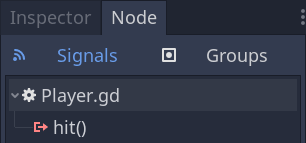
在 _on_Player_hit() 函数中获取并停止计时器。
func _on_Player_hit():
$MobTimer.stop()
// We also specified this function name in PascalCase in the editor's connection window
public void OnPlayerHit()
{
GetNode<Timer>("MobTimer").Stop();
}
如果你现在试玩游戏,你死亡后就会停止刷怪,现有的怪物会离开屏幕。
你可以鼓励鼓励自己了:你做出了完整 3D 游戏的原型,虽说还有点粗糙。
在此基础上,我们将会添加计分、重启游戏的选项,你还会看到如何使用简单的动画让游戏变得更加活灵活现。
代码检查点¶
这些事 Main、Mob、Player 节点的完整脚本,仅供参考。你可以把它们和你的代码进行对比检查。
首先是 Main.gd。
extends Node
export(PackedScene) var mob_scene
func _ready():
randomize()
func _on_MobTimer_timeout():
# Create a new instance of the Mob scene.
var mob = mob_scene.instance()
# Choose a random location on the SpawnPath.
var mob_spawn_location = get_node("SpawnPath/SpawnLocation")
# And give it a random offset.
mob_spawn_location.unit_offset = randf()
# Communicate the spawn location and the player's location to the mob.
var player_position = $Player.transform.origin
mob.initialize(mob_spawn_location.translation, player_position)
# Spawn the mob by adding it to the Main scene.
add_child(mob)
func _on_Player_hit():
$MobTimer.stop()
public class Main : Node
{
#pragma warning disable 649
[Export]
public PackedScene MobScene;
#pragma warning restore 649
public override void _Ready()
{
GD.Randomize();
}
public void OnMobTimerTimeout()
{
// Create a new instance of the Mob scene.
var mob = (Mob)MobScene.Instance();
// Choose a random location on the SpawnPath.
// We store the reference to the SpawnLocation node.
var mobSpawnLocation = GetNode<PathFollow>("SpawnPath/SpawnLocation");
// And give it a random offset.
mobSpawnLocation.UnitOffset = GD.Randf();
// Communicate the spawn location and the player's location to the mob.
Vector3 playerPosition = GetNode<Player>("Player").Transform.origin;
mob.Initialize(mobSpawnLocation.Translation, playerPosition);
// Spawn the mob by adding it to the Main scene.
AddChild(mob);
}
public void OnPlayerHit()
{
GetNode<Timer>("MobTimer").Stop();
}
}
然后是 Mob.gd。
extends KinematicBody
# Emitted when the player jumped on the mob.
signal squashed
# Minimum speed of the mob in meters per second.
export var min_speed = 10
# Maximum speed of the mob in meters per second.
export var max_speed = 18
var velocity = Vector3.ZERO
func _physics_process(_delta):
move_and_slide(velocity)
func initialize(start_position, player_position):
look_at_from_position(start_position, player_position, Vector3.UP)
rotate_y(rand_range(-PI / 4, PI / 4))
var random_speed = rand_range(min_speed, max_speed)
velocity = Vector3.FORWARD * random_speed
velocity = velocity.rotated(Vector3.UP, rotation.y)
func squash():
emit_signal("squashed")
queue_free()
func _on_VisibilityNotifier_screen_exited():
queue_free()
public class Mob : KinematicBody
{
// Emitted when the played jumped on the mob.
[Signal]
public delegate void Squashed();
// Minimum speed of the mob in meters per second
[Export]
public int MinSpeed = 10;
// Maximum speed of the mob in meters per second
[Export]
public int MaxSpeed = 18;
private Vector3 _velocity = Vector3.Zero;
public override void _PhysicsProcess(float delta)
{
MoveAndSlide(_velocity);
}
public void Initialize(Vector3 startPosition, Vector3 playerPosition)
{
LookAtFromPosition(startPosition, playerPosition, Vector3.Up);
RotateY((float)GD.RandRange(-Mathf.Pi / 4.0, Mathf.Pi / 4.0));
float randomSpeed = (float)GD.RandRange(MinSpeed, MaxSpeed);
_velocity = Vector3.Forward * randomSpeed;
_velocity = _velocity.Rotated(Vector3.Up, Rotation.y);
}
public void Squash()
{
EmitSignal(nameof(Squashed));
QueueFree();
}
public void OnVisibilityNotifierScreenExited()
{
QueueFree();
}
}
最后是最长的脚本 Player.gd。
extends KinematicBody
# Emitted when a mob hit the player.
signal hit
# How fast the player moves in meters per second.
export var speed = 14
# The downward acceleration when in the air, in meters per second squared.
export var fall_acceleration = 75
# Vertical impulse applied to the character upon jumping in meters per second.
export var jump_impulse = 20
# Vertical impulse applied to the character upon bouncing over a mob in meters per second.
export var bounce_impulse = 16
var velocity = Vector3.ZERO
func _physics_process(delta):
var direction = Vector3.ZERO
if Input.is_action_pressed("move_right"):
direction.x += 1
if Input.is_action_pressed("move_left"):
direction.x -= 1
if Input.is_action_pressed("move_back"):
direction.z += 1
if Input.is_action_pressed("move_forward"):
direction.z -= 1
if direction != Vector3.ZERO:
direction = direction.normalized()
$Pivot.look_at(translation + direction, Vector3.UP)
velocity.x = direction.x * speed
velocity.z = direction.z * speed
# Jumping.
if is_on_floor() and Input.is_action_just_pressed("jump"):
velocity.y += jump_impulse
velocity.y -= fall_acceleration * delta
velocity = move_and_slide(velocity, Vector3.UP)
for index in range(get_slide_count()):
var collision = get_slide_collision(index)
if collision.collider.is_in_group("mob"):
var mob = collision.collider
if Vector3.UP.dot(collision.normal) > 0.1:
mob.squash()
velocity.y = bounce_impulse
func die():
emit_signal("hit")
queue_free()
func _on_MobDetector_body_entered(_body):
die()
public class Player : KinematicBody
{
// Emitted when the player was hit by a mob.
[Signal]
public delegate void Hit();
// How fast the player moves in meters per second.
[Export]
public int Speed = 14;
// The downward acceleration when in the air, in meters per second squared.
[Export]
public int FallAcceleration = 75;
// Vertical impulse applied to the character upon jumping in meters per second.
[Export]
public int JumpImpulse = 20;
// Vertical impulse applied to the character upon bouncing over a mob in meters per second.
[Export]
public int BounceImpulse = 16;
private Vector3 _velocity = Vector3.Zero;
public override void _PhysicsProcess(float delta)
{
var direction = Vector3.Zero;
if (Input.IsActionPressed("move_right"))
{
direction.x += 1f;
}
if (Input.IsActionPressed("move_left"))
{
direction.x -= 1f;
}
if (Input.IsActionPressed("move_back"))
{
direction.z += 1f;
}
if (Input.IsActionPressed("move_forward"))
{
direction.z -= 1f;
}
if (direction != Vector3.Zero)
{
direction = direction.Normalized();
GetNode<Spatial>("Pivot").LookAt(Translation + direction, Vector3.Up);
}
_velocity.x = direction.x * Speed;
_velocity.z = direction.z * Speed;
// Jumping.
if (IsOnFloor() && Input.IsActionJustPressed("jump"))
{
_velocity.y += JumpImpulse;
}
_velocity.y -= FallAcceleration * delta;
_velocity = MoveAndSlide(_velocity, Vector3.Up);
for (int index = 0; index < GetSlideCount(); index++)
{
KinematicCollision collision = GetSlideCollision(index);
if (collision.Collider is Mob mob && mob.IsInGroup("mob"))
{
if (Vector3.Up.Dot(collision.Normal) > 0.1f)
{
mob.Squash();
_velocity.y = BounceImpulse;
}
}
}
}
private void Die()
{
EmitSignal(nameof(Hit));
QueueFree();
}
public void OnMobDetectorBodyEntered(Node body)
{
Die();
}
}
在下一节课中我们会添加计分和重试选项,再见。